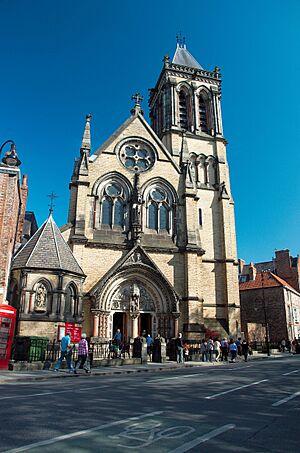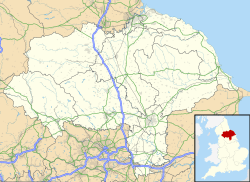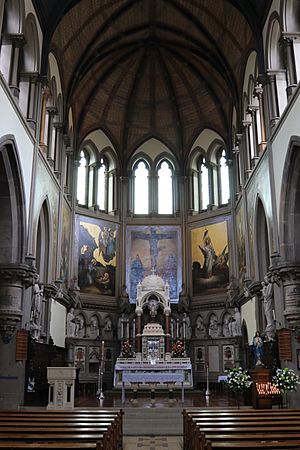York Oratory facts for kids
Quick facts for kids York Oratory |
|
|---|---|
| Oratory Church of Saint Wilfrid, York | |

The building in 2011
|
|
| 53°57′41.4″N 1°5′7.75″W / 53.961500°N 1.0854861°W | |
| OS grid reference | SE 60151 52127 |
| Location | York |
| Country | England |
| Denomination | Roman Catholic |
| Tradition | Oratory of Saint Philip Neri |
| Website | https://www.yorkoratory.com/ |
| History | |
| Dedication | Saint Wilfrid |
| Consecrated | 14 July 1945 |
| Architecture | |
| Heritage designation | Grade II listed |
| Architect(s) | George Goldie |
| Completed | 1864 |
| Construction cost | £10,000 |
| Specifications | |
| Length | 96 feet (29 m) |
| Width | 51 feet (16 m) |
| Nave width | 27 feet (8.2 m) |
| Height | 147 feet (45 m) |
| Bells | 11 (1995/96 & 2019) |
| Administration | |
| Parish | Saint Wilfrid, York |
| Diocese | Diocese of Middlesbrough |
| Province | Archdiocese of Liverpool |
The Oratory Church of Saint Wilfrid, York (or York Oratory for short) is a Catholic church in York, England.
A church named after Saint Wilfrid has been in York since the Middle Ages. This church is often called the "Mother Church of the city of York" because of its long history. It is built in the Gothic Revival style, which means it looks like churches from the 13th and 14th centuries. The arch above its main door has the most detailed carvings from the Victorian era in the city.
The church you see today was finished in 1864. Many people think it is one of the most beautifully completed Catholic churches in England. It is full of amazing sculptures, paintings, and stained glass. In 2013, the church was given to the care of the Oratorian Fathers, a group of priests. It is part of the Diocese of Middlesbrough.
Contents
History of Saint Wilfrid's Church
For a long time, a church dedicated to Saint Wilfrid has been important in York. In the early 1500s, Saint Wilfrid's was connected to Saint Mary's Abbey. This meant the Abbey had a say in who became the priest there.
By 1585, the church was no longer used and was taken down. Its land was built over, and its parish joined with another church, Saint Michael le Belfry. However, Catholic people in York brought Saint Wilfrid's parish back in 1742. They started their new mission in Little Blake Street. This mission was set up by Edward Dicconson, a leader of the Catholic Church in Northern England.
Early Catholic Worship in York
A house for Catholic priests, called Chapel House, was set up at number 7 Little Blake Street (now Duncombe Place). In 1760, the first public place for Catholics to worship opened in York. This chapel was used until 1802. Then, a new chapel was built across the street, where the church stands today.
At that time, many people still had strong feelings against Catholics. So, the chapel was hidden from the street by the priest's house. This way, it was less noticeable. The chapel could hold 700 people, and the number of Catholics in York kept growing.
Building the Present Church
The current Oratory Church was built on the site of the old hidden chapel. In 1848, there were plans to build a new church. However, the money was used instead to build a much-needed church in the Walmgate area. This was for the many Irish Catholics who came to York during the Great Famine. That church, Saint George's Church, became very important for the Catholic diocese of Beverley.
In 1859, the city of York planned a new road to Lendal Bridge. This led Dean Duncombe to ask the city to continue the road past the chapel and towards the Minster. The old, narrow lane was replaced with a wide street. Houses on the opposite side of the chapel were taken down, and the road was made wider. This new wide street was named Duncombe Place, after the Dean.
Saint Wilfrid's became a very important church for the Beverley Diocese. But this did not last long. The Beverley diocese was later divided into two new dioceses: Leeds (south of the River Ouse) and Middlesbrough (north of the river). The Church of Saint Wilfrid is often called the "Mother Church of the City of York" by Catholics. This is because its history is linked to the first time the Catholic faith openly returned to the city.
Architecture and Design
The architect who designed the Oratory Church we see today was George Goldie. He was the son of an important member of the church and was even baptized in the old Saint Wilfrid's chapel. He also designed Saint Wilfrid's Primary School nearby, but he passed away in 1887 before the school was built.
The church was designed in the Gothic Revival style. This means it copies the look of churches from the 13th and 14th centuries. The arch above the main door has the most detailed Victorian carvings in all of York.
Construction and Completion
The first stone of the church was laid in April 1862 by Bishop Cornthwaite. The church was finished in 1864 and cost £10,000. It was officially opened by Cardinal Wiseman in June 1864. At the time, it was thought to be "one of the most perfectly finished Catholic Churches in England." It was praised for its rich sculptures, stained glass, and beautiful fittings.
During renovations in the 1800s, part of a porch was found under the floor of the Assembly Rooms. People believe this piece belonged to the original Saint Wilfrid's Church from long ago. In 1968, the church became a Grade II listed building. This means it is a special building that is protected because of its historical or architectural importance.
The Tower and Bells
The church's tower is about 147 feet high. You can see it from many parts of York. The way the tower is designed makes it look taller than the Minster behind it. But once you pass the Oratory Church, you can see that the Minster is actually taller.
The tower has a beautiful set of ten bells. There is also an Angelus bell, added in 2019 and named "John Henry." The heaviest eight bells were made in 1938. These bells were first made by Gillett & Johnston in Croydon and put in Saint John's Church in Thornham. In 1993, they became available and were moved to Saint Wilfrid's. Two lighter bells were added in 1995 to make a total of ten. These were made by John Taylor & Co. One bell is named "Saint Wilfrid." The other has a special message: "Ringers ring with one accord. Make beautiful music to praise the Lord."
Church Furnishings
The altar rails at the Oratory are very special and worth noticing. They were made in 1948 by Wilfrid Dowson from Kirkbymoorside. He also did some work at York Minster and made the Queen's Gates at Saint George's Chapel in Windsor Castle. The rails were changed and temporarily taken away in February 2007. The organ in the church was built in 1867 by Forster and Andrews. It was restored in 1998 by Harrison & Harrison.
Parish Life and Music
The church holds Mass every day. The Traditional Latin Mass is celebrated at 8:15 AM from Monday to Friday, 9:15 AM on Saturday, and 12:00 PM on Sunday. The Novus Ordo Mass (in English) is celebrated daily at 12:10 PM, on Saturday at 5:00 PM, and on Sunday at 8:30 AM and 10:30 AM.
Every Sunday, the church also has sung Vespers at 4:00 PM, followed by Benediction at 4:30 PM.
The Oratory is well-known for its high quality of music. A volunteer choir sings at the 10:30 AM English Mass. Professional singers perform at the 12:00 PM Latin Mass. They sing traditional church music, including chant and polyphony.
The Oratory offers four special music scholarships through the University of York. These are for both undergraduate and postgraduate students, both male and female. The scholarships help create a singing group with sopranos, altos, tenors, and basses.
The church's rectory (the priest's house) is in Petergate House. In 1945, the Middlesbrough Diocese bought a 16th-century house in the Shambles. This house, number 35, is now a special place for Saint Margaret Clitherow. She was a Catholic who was martyred (killed for her faith) in York. It is a place where Catholics from all over the world come to visit.




